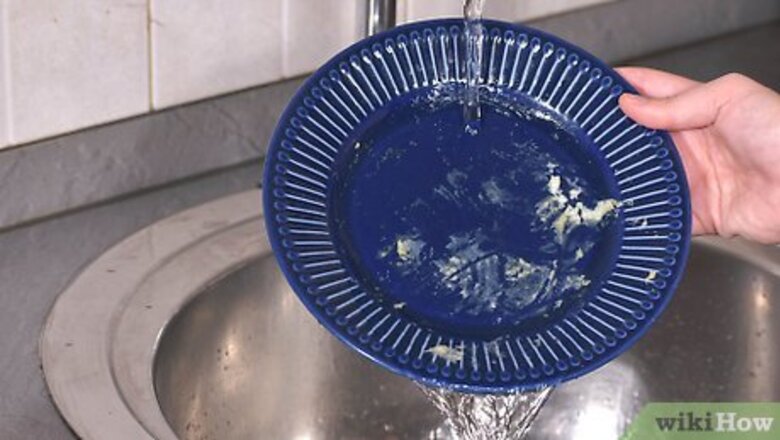
views
Loading the Dishwasher
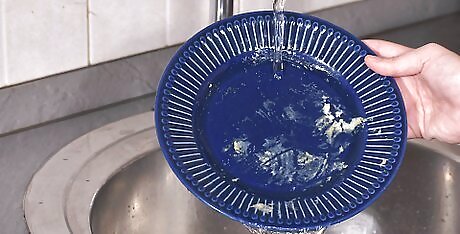
Rinse your dishes. If you simply toss dirty dishes in your dishwasher, they will not come clean. Before placing your dishes in the washer, run them under tap water from the sink to remove bits of food, condiments, and other substances. This dishes do not have to be completely polished before you place them in the sink. However, they should be free of excess food before washing.
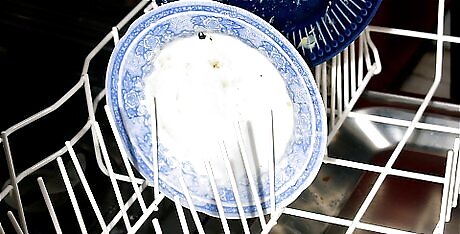
Load the bottom rack. On the bottom rack, load dishes like pots, pans, casserole dishes, bowls, and plates. Make sure all your dishes face the spray nozzle of your dishwasher. Angle everything down slightly. This will help ensure a more thorough cleaning. You should also load silverware in the silverware rack. Flat pots and platters should be placed near the back of the dishwasher. Make sure stainless steel and silver dishes do not touch. If they touch during the wash, this can cause a chemical reaction that will damage your dishes.
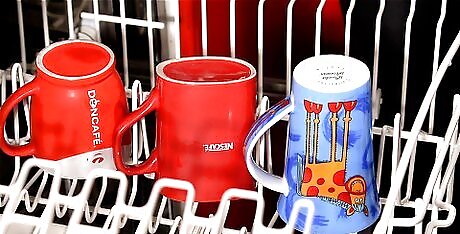
Load the top rack. Glasses and mugs go in the top rack. Place these face down in the dishwasher and angle them as much as possible to get the insides washed. When washing wine glasses, make sure to angle them so they do not wiggle in the wash. Wine glasses can break easily in the dishwasher. It may be best to hand wash expensive wine glasses.
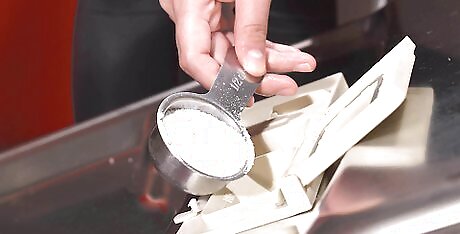
Use the correct amount of detergent. You do not need a lot of detergent. Too much detergent can cause soap residue to stick to dishes. Check your detergent's label to see how much to add. Do not add more, even if your dishes are very dirty. Never use regular dish soap in the dishwasher. These manual soaps are designed to clean with suds in the sink. Using them in the dishwasher will create an overflow! Use powder or liquid detergent instead of pods. Powder and liquid detergent clean better and are less expensive than pods.
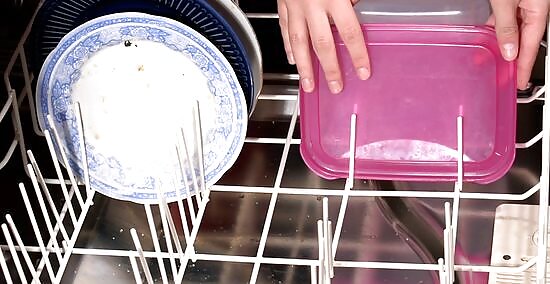
Be careful when loading plastics. Plastic items are lightweight and can move around easily during the wash. Make sure to place them on racks that keep them secure. They should not wiggle in place, as this can cause them to become dislodged during the wash.
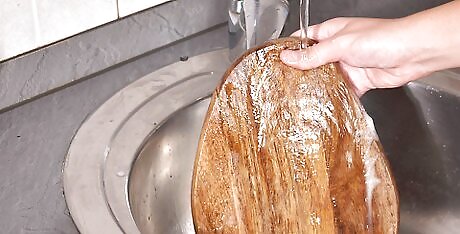
Avoid loading certain items. Not everything should be washed in the dishwasher. Refrain from placing the following items in a dishwasher: Materials like wood, cast iron, pewter, sterling silver, and aluminum Children's glasses with designs Nonstick dishes Expensive dishes
Running the Dishwasher
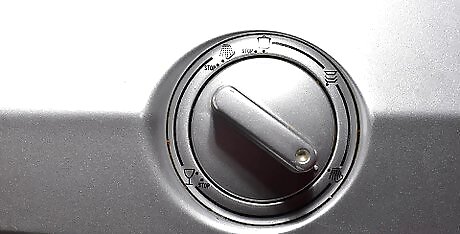
Run the lightest cycle, if possible. To save water, you should usually opt for the lightest cycle on your dishwasher. If your dishes are not extremely dirty, this should clean them thoroughly. The dishes you normally use in the week for eating, drinking, and cooking should come clean on a light cycle.

Choose a more intense cycle for dirtier dishes. Very dirty dishes, such as those used for heavy cooking or baking, may need a stronger wash. Usually, switching from a light wash to a normal wash should clean off most built up residue. Dishes with set in stains can be washed using a heavy wash. Greasy dishes would benefit from a hight-temp wash.
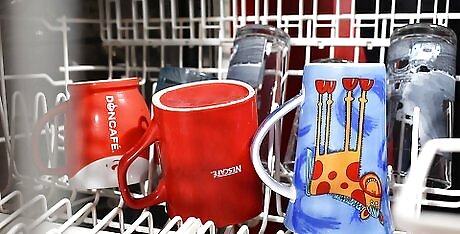
Let the dishes air dry in most circumstances. Skipping the dry cycle saves energy. Unless you need to use the dishes immediately, allow them to air dry in the rack before putting them away.
Cleaning the Dishwasher
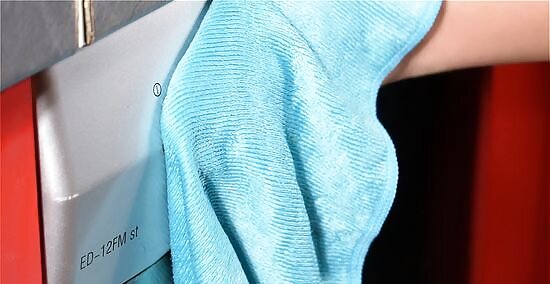
Clean the exterior. To start, you want to scrub off the exterior of your dishwasher. This will remove things like spilled food and fingerprints. Plastic dishwashers should be wiped down with a sponge and soapy water. Stainless steel dishwashers should be wiped down using glass cleaner. If you're using glass cleaner, do not spray it directly on the dishwasher. Moisture can cause harm to electronic coils. Apply the glass cleaner to a paper towel or a rag first and then use that to wipe off smudges, spills, and fingerprints.
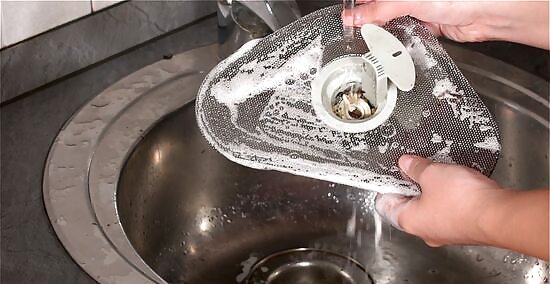
Clean the filter. Dishwashers have built-in filters that should be cleaned regularly to keep the dishwasher running smoothly. The filter is found on the bottom rack and can be easily pulled out. For precise instructions on removing your filter, refer to your dishwasher's instruction manual. Clean the filter in your sink. Use a sponge or the spray setting on your faucet to clean out food and debris stuck in the filter. When you're done, put the filter back in place. If you notice anything grainy, like coffee grounds, these can be cleaned out using a small brush.
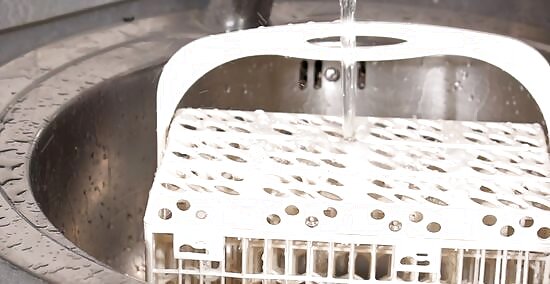
Remove and clean the accessories. Take out any removable parts of your dishwasher, such as utensil holders. Transfer them to the sink and rinse out any stuck on food using tap water. If accessories are only mildly dirty, you may be able to remove foods with running water alone. You may need to use a brush or sponge to remove foods from very dirty filters.
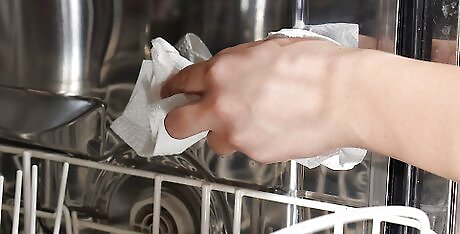
Wipe down the tub. Before cleaning the tub, use paper towels to remove food scraps, dirt, and debris from the bottom of the dishwasher. Then, set a cup of white vinegar on the top rack of the dishwasher. Make sure the cup you use is dishwasher safe. Run a full cycle with the cup in place. This should clean and deodorize your dishwasher's interior. Wipe down the interior of the dishwasher with a paper towel after running a cleaning cycle. EXPERT TIP Raymond Chiu Raymond Chiu House Cleaning Professional Raymond Chiu is the Director of Operations for MaidSailors.com, a residential and commercial cleaning service based in New York City that provides home and office cleaning services at affordable prices. He has a Bachelors in Business Administration and Management from Baruch College. Raymond Chiu Raymond Chiu House Cleaning Professional Expert Trick: Run an empty dishwasher with a cup of vinegar once a month to keep your dishwasher as clean as possible.




















Comments
0 comment